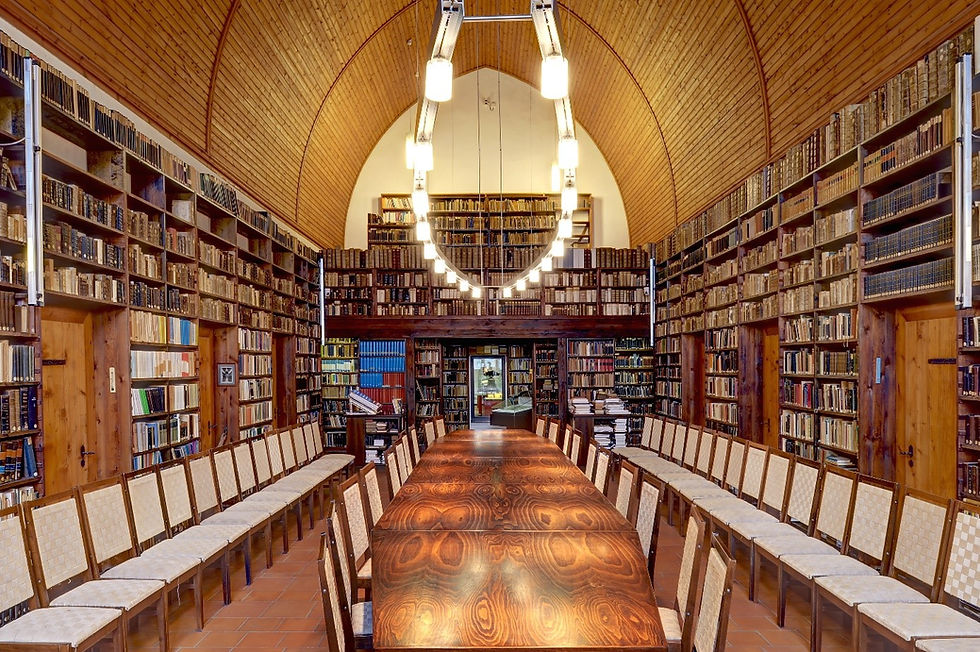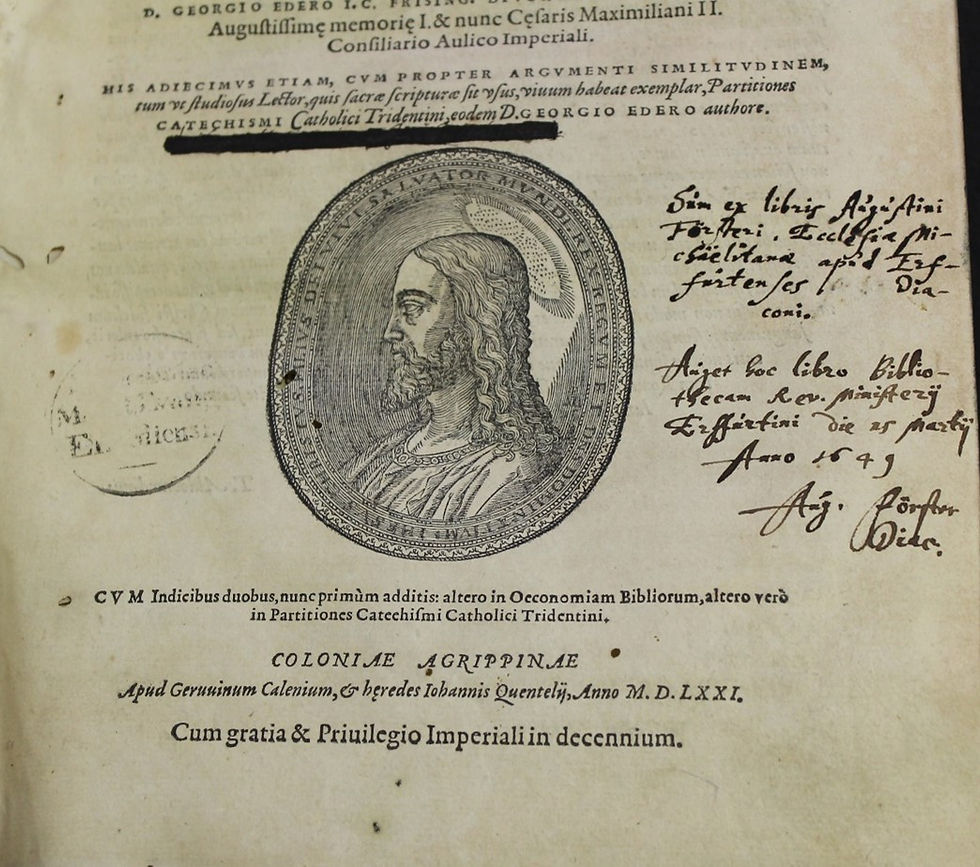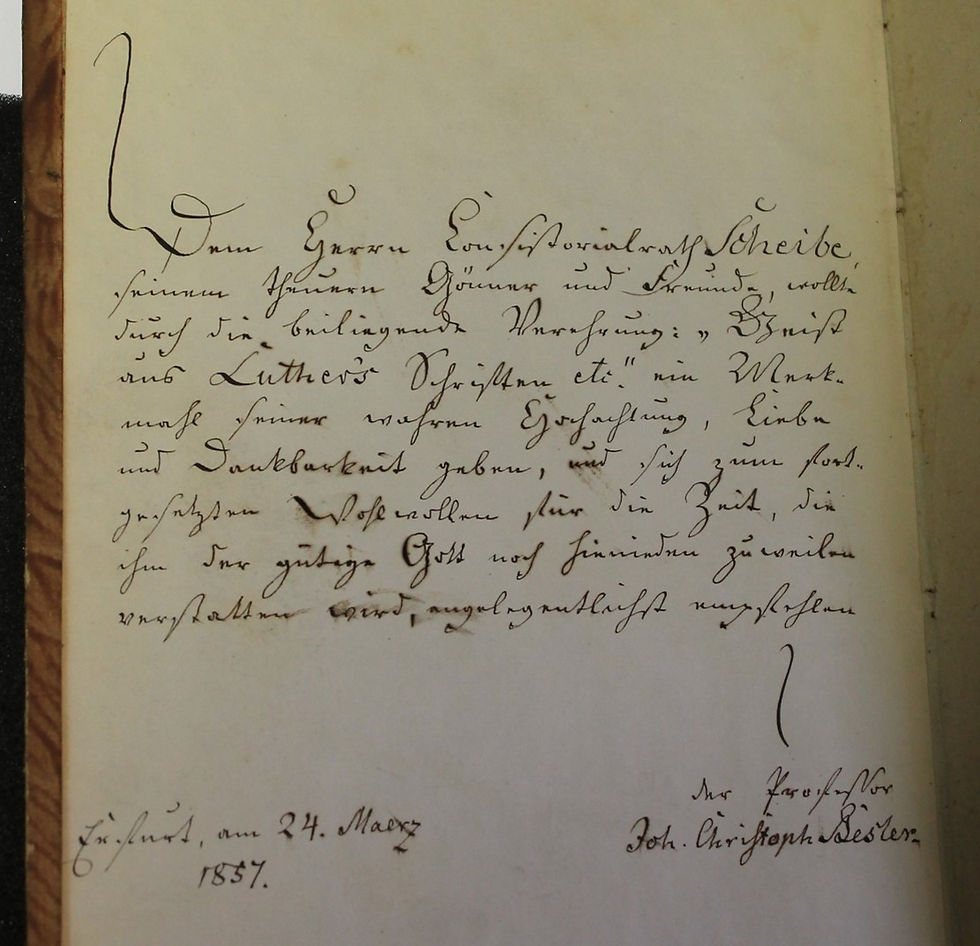Constanze Schaller | Max Weber Center, University of Erfurt
Libraries are more than just books lumped together in a room. And books, for their part, carry more than their (table of) contents and the knowledge contained in them. Books carry the traces of people using and owning them, of the places where they were made, traded, and read, and of the social practices in which they played a part. Tracing these small, even tiny, parts of books is highly important: stamps, marginals and dedications allow us to reconstruct provenances, social practices, and customs. At times, they also allow us to gain an impression of the people behind the books, like Michael Altenburg, a protestant benefactor of a library pursuing Martin Luther’s ideals. His and other book dedications are a fascinating window that allows us to discover how dedications as a common practice worked in early modern Erfurt in central Germany and how they changed books as objects, influencing their value.

Michael Altenburg (1608-1685) was the son of a well-known pastor, cantor, and composer of Protestant songs in Erfurt. He himself worked as a protestant councillor and was part of the St. Andrew’s church there. By virtue of his position, he had access to Erfurt’s Library of the Protestant Ministry. This was an important counterpart to Catholicism and shaped the urbanity of Erfurt due to the unusual religious situation there of regulated biconfessionality since the 17th century. In order to found this library in 1646, seventeen protestant pastors gathered books from their private libraries to provide an initial stock of forty books. The ideal of education was an important factor for founding and maintaining this library, following the ideal for libraries and schools sketched out by Martin Luther in his Ratsherrenschrift (Letter to the Councillors, printed in Wittenberg, 1524). To ensure that the collection would grow continuously, an important custom was introduced: all Protestant pastors starting their service in and around Erfurt had to donate at least one useful book to the library. In return, those pastors could use the library as a working space, for example to consult the collection when preparing their sermons.
Not all pastors had enough money to buy necessary books on their own and set up private libraries, so they built one to share for the Protestant Pastorate of Erfurt. Using this library, however, went beyond reading the books. By contributing to the library, individuals could help the Protestant Pastorate and become part of a growing social practice of donating. Starting from the regulation of donating one book, a whole donation practice emerged, which led to the rapid growth of the library. Already in the first years, several books were donated at other occasions, like anniversaries, as well as the mandatory book whenever a pastor started his service.
Some of the donations are documented in the Liber Fvndationis, the ‘book of donations’, but mostly it is the handwritten dedications inside the books that provide information. If we look between the covers, we can see how individual those dedications are and what they tell us about the donors and books as well as the custom of writing dedications.
![Vincenzo Bruno: ‘Societatis Iesv, Meditationes […] Pars Seconda’ with handwriting notes inside. The book has brass closures and is held on the top left by a black strap.](https://static.wixstatic.com/media/1d2c57_183269766584411885a0f535f45b5391~mv2.jpg/v1/fill/w_980,h_782,al_c,q_85,usm_0.66_1.00_0.01,enc_avif,quality_auto/1d2c57_183269766584411885a0f535f45b5391~mv2.jpg)
Right before the title page, Michael Altenburg wrote his Latin dedication into the book he was about to donate (see image 2), which is ‘Societatis Iesv, Meditationes […] Pars Secundum’ written by Vincenzo Bruno and printed in Cologne in 1598 (see a digitalized later edition of this book here). In his dedication, Altenburg writes that he is offering this book out of generosity (ex munificentia) to the library of the Protestant Ministry in Erfurt on 16 February 1648. Similar to other dedications, the library on the receiving end is explicitly mentioned (bibliothecam Reverendiss Ministerii Erford Auguste confessionis) as well as the exact date of the donation. Emphasizing his generosity, Altenburg is staging himself as a special benefactor, which is also a recognizable element in many dedications.
Donations were not just an opportunity to do a good thing for the community of pastors. For Michael Altenburg and his peers, it was also a chance to ‘immortalize’ the memory of one’s person and name. The donors assumed that their books would be preserved in this library for a long time and certainly beyond their death. By writing their names into the books, they wrote themselves into the history and, at the same time, into the collective memory of the library. The books not only carried the wisdom collected in their contents, but also preserved the memory of the donors and the donation practice.
Altenburg’s dedication is not the only handwriting that can be found in the book. On the title page, there is another one, which has been crossed out. Crossing out or removing former dedications as well as ownership entries was more common than one might think today. Books were expensive, they were handed down and circulated between owners, sometimes as gifts or as legacies. In this case, dedications and ownership entries were a welcome memento of former owners, and kept. In other instances, however, the new owners did not want to be reminded of those who had come before them and so tried to remove the marks and traces of them.

If dedications and former
property marks are still visible today, they frequently hint at the provenance of the books and showcase the custom and practice of dedications.
In this next book, former ownership entries have mostly been erased (see image 3). One is scratched out (see image 4) and the other one is removed partially leaving only some traces and hints of letters. We can only guess whether the new owner himself crossed out the previous ones, and why.
This second book, written by Georg Eder, was printed in Cologne in 1571 under the title “Oeconomia Bibliorum". The dedication is written in Latin by Augustinus Förster (1605-1683), but is narrated by the dedication itself (see image 4). It tells us, that the book originates from the private library of Förster, a deacon of St. Michaels Church in Erfurt. As in the case of Michael Altenburg, Förster lists the exact date of the donation (25 March 1649) and the name of the benefitting institution (Bibliothecam Rev. Ministerii) as well as his own name as donor (Augustinus Förster).

Narratives within the dedications are individual and do vary, but single elements are recognizable and can be found in different dedications. The custom of writing dedications or marking your own books through ownership entries did not emerge within the library of the Protestant Ministry in Erfurt, it follows a longer tradition. Dedications were an inconspicuous and ordinary way of handling books, which is connected to the social practice of gifting. Books as gifts represent relationships and power constellations between people, which are further expressed through the dedications. They can be found for example in books of reigns within royal libraries, or in humanist libraries of the 16th century, where books circulated between owners and had different symbolic meanings. The dedications of Michael Altenburg and Augustinus Förster offer only a fraction of examples of this widespread custom, which can be found in many libraries of different cities and centuries. If we take another look into the library in Erfurt, we can trace dedications and ownership entries from different centuries.
The following example is a book from the 19th century (see image 5). It found its way into the library through Friedrich Ludwig Scheibe (1809-1884), who was a senior of the Protestant Ministry. Before he donated the book to the Library of the Protestant Ministry, he got it from Johann Christoph Besler (1787-1866). The German dedication written by Besler tells us more: he gave the book to Scheibe in 1857 as a symbol of his true respect, love, and gratitude (ein Merkmahl seiner wahren Hochachtung, Liebe und Dankbarkeit) towards him. Typical elements of dedications are recognizable: the donor's name, the date of the donation (24 March 1857) and the one benefitting from it (Scheibe). Furthermore, Besler mentions, what exactly he is gifting: a series of nine books with the title 'Geist aus Luthers Schriften' (Spirit from Luther's writings, printed in Darmstadt in 1828) and expressing the wish of experiencing the continued goodwill of Scheibe for his remaining time on this earth (sich zum fortgesetzten Wohlwollen für die Zeit […] hienieden […] angelegentlichst empfehlen). By this Besler is valuing his friendship with Scheibe, and staging him as an important person in his life.

Dedications, as individual as they were, did have some similarities. Using established and therefore recognizable elements, the writers follow the tradition of the dedication practice. By contributing to the library of the Protestant Ministry, they not only shaped its character but also became part of the group of donors. Their names are preserved and connected to the books here, visible for future generations, remembering the persons as benefactors of this centre of protestant education.
In general, dedications can provide multiple pieces of information, which, if read and interpreted correctly, can help understand practices and customs, and reconstruct the value and meaning of books. Through handwritten dedications, printed copies of books are customized, making them unique and irreplaceable. As objects, these books were transformed not only for the pastors reading them in Erfurt but also for researchers centuries later. To them, the little inscriptions are a key ingredient for their study in a variety of academic disciplines like book culture, social and cultural history as well as theology. By studying those dedications, their purpose is served, reminding us of the people connected to the books.
Further Readings:
Sherman, William H.: Used Books: marking readers in Renaissance England (Philadelphia: University of Pennsylvania Press, 2008).
Jackson, H. J., Romantic Readers (New Haven and London: Yale University Press, 2005).
Erll, Astrid; Nünning, Ansgar and Young, Sara B., Cultural memory studies: an international and interdisciplinary handbook (Berlin and New York: de Gruyter, 2008).
Constanze Schaller is a doctoral fellow of the research group “Religion and Urbanity” of the Max Weber Research Center in Erfurt. She is working on the historical Library of the Protestant Ministry and examines its growth from the seventeenth to the nineteenth century and how the library and actors connected to it influenced certain urban settings of Early Modern Erfurt.



